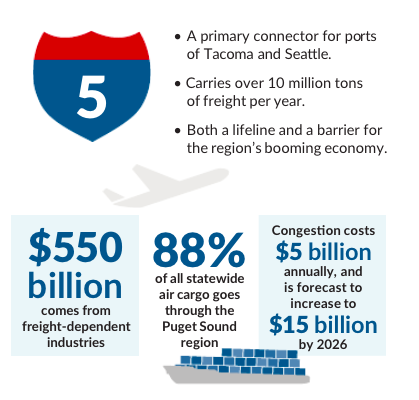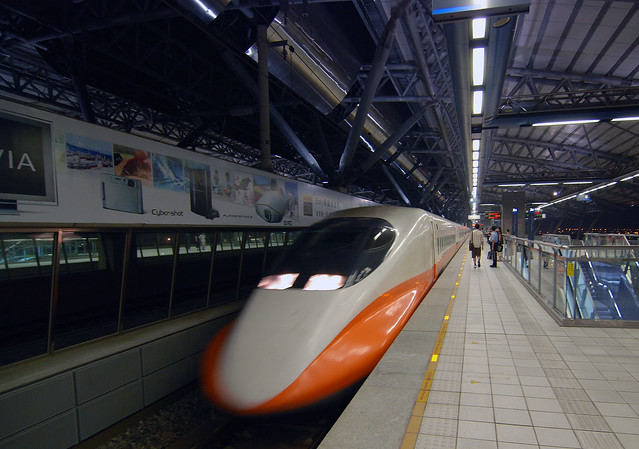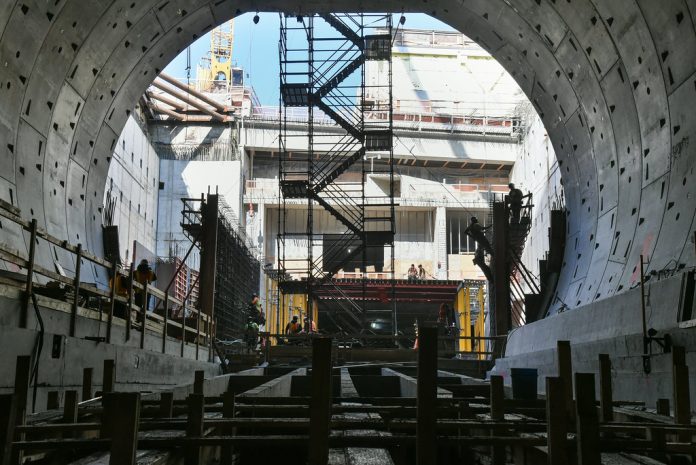Less than a year after the opening of the SR-99 tunnel, tunnel mania seems to be spreading across Seattle. An unfunded billion dollar price tag has not scared off supporters of deluxe tunnel options for Sound Transit 3 alignments in both West Seattle and Ballard. Seattle Subway’s newly released Sound Transit 4 vision map has gotten transit riders across the region dreaming of a comprehensive mass transit system where riders could hop on in neighborhoods like Georgetown and Greenwood currently cut out from light rail plans.
But dreams of burrowing beneath Seattle’s hills are not restricted to the topic of transit. A mysterious publication sent by mail to over a dozen of Seattle’s government, business, and community leaders has put forth a concept for another subterranean mega project: Why not replace the Downtown Seattle segment of I-5 with a deep bore tunnel that runs under Capitol Hill?
Self-published by mystery-person author Cheval Tepier, Integrate I-5: Reimagining Interstate 5 in Downtown Seattle makes the argument that a deep bore tunnel would allow for better integrating the highway into Downtown Seattle’s built environment and transportation systems than either the status quo or other options currently on the table, notably lidding I-5.

With the SR-99 tunnel finally signed, sealed, and delivered, Tepier believes a tunneling project that removes I-5 from Seattle’s downtown core plays into the region’s expertise. “No one does tunneling through consolidated muck as well or as often as Seattle,” Tepier writes in Integrate I-5. “The whole blown-gasket tribulations of Bertha aside, it’s positively amazing how accomplished this region is at getting around by going deep.”
A new solution for I-5 in Downtown Seattle?
As emphasized in the Washington State Department of Transportation’s (WSDOT) recent I-5 Systems Partnership: A Call to Action, the entire I-5 corridor is need of updates that go far beyond a facelift. The cost of covering deferred maintenance, such as preserving pavement and seismically retrofitting vulnerable structures, is estimated at $2.5 billion.
Catching up with deferred maintenance won’t address the chronic congestion on I-5, which is estimated to cost local and regional economies about $5 billion annually, a figure that is projected to rise to $15 billion annually in 2026.

According to Tepier, a deep bore tunnel solution for I-5 would accomplish:
- Replacement of a functionally obsolete link in the I-5 corridor;
- A complete re-stitching of the urban fabric across the highway;
- Provision for HOV lanes through the city in both directions;
- Creation of at least 25 acres of urban parkland;
- Restoration of up to 45 acres of real estate; and
- A more affordable alignment for ST3.
Let’s dig in a little bit deeper to these selling points, beginning with the first one. It’s true that 2.9 mile segment of I-5 that runs through the downtown core is one of the biggest chokepoints for traffic in the entire corridor, in no small part because of the high density of entrance and exit ramps. Boring a new tunnel would give engineers the opportunity to start from scratch, but it presents its own complications as well, such as should the north and south portal sites be located? How could traffic patterns with I-90 and SR-520 be merged? How could access be maintained to the downtown core?
In reference to that last question, Tepier proposed building a new urban boulevard, dubbed Salish Way. While Tepier claims Salish Way would not be as “sprawling” as I-5, it would still function as arterial for surrounding streets. Does that truly constitute a re-stitching of the urban fabric? Think of Boren Avenue, another nearby arterial that slices through First Hill.
Tepier estimates that land dedicated to Salish Way and connector streets would take up about 25% of the approximate 100 acres that would be created by filling in the interstate. While that represents a sizable chunk of land, it does leave 70 acres available for development. Tepier argues for reserving the bulk of the land, 45 acres for developable land, would help defray the projects costs. The remaining 25 acres would be dedicated to green space that would enhance existing parkland, such as Freeway Park.
One of the plans most intriguing selling points is how it could fit into station locations for coming light rail. Tepier argues that using reclaimed land from I-5 would remove the need to dig trenches for three of five future stations planned for Downtown. But the stations suggested are admittedly described as “downtownish” in recognition that they would not be as centrally located as some of the station plans in the works right now.
Tepier’s proposed light rail station locations include:
- International District under 5th Ave S and S Jackson St;
- Marion/Madison and Salish Way (6th Ave)—built in reclaimed land;
- Pike/Pine at the Convention Center—built in reclaimed land;
- Thomas/John and Salish Way (Eastlake Ave)—built in reclaimed land; and
- Mercer and Westlake.
Although the locations might not be ideal for Downtown access, Tepier argues that the cost savings and convenience resulting from use of the former I-5 right-of-way would make up for it.
What questions does a tunnel raise?
As intriguing as the tunnel solution is, there are some major questions to consider in response to the concept. A big one is whether or not it’s responsible to invest so much into infrastructure aimed at moving vehicles through Seattle. Does it lock in carbon emissions far into the future? Would the project itself be highly carbon intensive?
Tepier is honest about what such a plan could cost, candidly writing: “It’s going to be extraordinarily expense. We’re talking ‘begins with a B’ many times over.” Using the SR-99 tunnel for comparison, Tepier rounds the tunnel cost up to $4 billion to account for inflation, and then estimates that the I-5 tunnel would cost roughly two to three times as much, a whopping $8 billion to $12 billion.
High-speed rail is another consideration. WSDOT is currently exploring how to form and deliver a high speed rail system that would stretch across the state, as part of a regional system connecting from Oregon to British Columbia. Using I-5 right-of-way could offer a significant cost saving advantage for a future high-speed rail project. By advocating for use of light rail stations in the right-of-way, the Integrate I-5 plan is currently incompatible with high-speed rail.

Finally, there’s the question of how Integrate I-5 compares to the concept of lidding I-5 in Downtown Seattle. Currently, an I-5 lid technical feasibility study is being undertaken by local firm WSP on behalf of Seattle’s Office of Planning and Community Development (OPCD). The technical feasibility study, which should be complete by April of 2020, is exploring the range of feasibility—technically and financially, as well as striving to create a framework to maximize benefits for all.

While Integrate I-5 does create more land than current lidding plans would, it would do so at greater expense. While a freeway lid might not as dramatically vanish I-5 from the downtown core as a tunnel replacement would, the more affordable price tag of a lid could allow for a replicable model across Seattle in suitable areas of the interstate, whereas it’s hard to imagine that more than one deep-bore I-5 tunnel would ever be constructed, even in a city as tunnel crazy as Seattle.
Still Tepier gives themselves little credit by self-declaring as a “nutcase responsible for [an] insane plan.” The book is well-thought out and researched. For those of us searching for a solution to the problem of I-5, it makes for compelling reading.
Copies of Integrate I-5 are available for purchase at Elliott Bay Books in Capitol Hill as well as online.
The author is a member of the Lid I-5 Steering Committee. Her thoughts and opinions are hers alone and do not represent Lid I-5.
Natalie Bicknell Argerious (she/her) is a reporter and podcast host at The Urbanist. She previously served as managing editor. A passionate urban explorer since childhood, she loves learning how to make cities more inclusive, vibrant, and environmentally resilient. You can often find her wandering around Seattle's Central District and Capitol Hill with her dogs and cat. Email her at natalie [at] theurbanist [dot] org.



